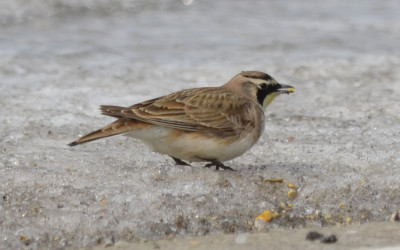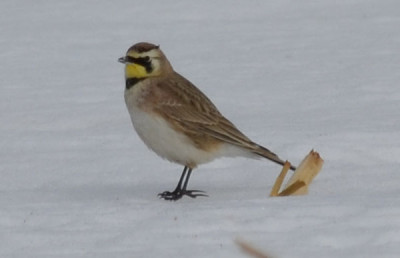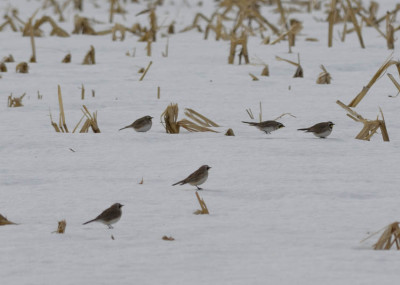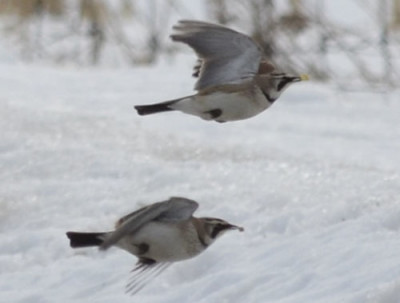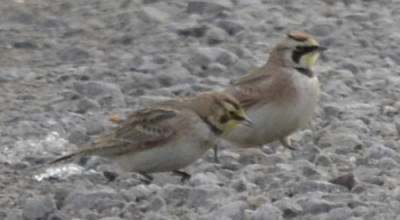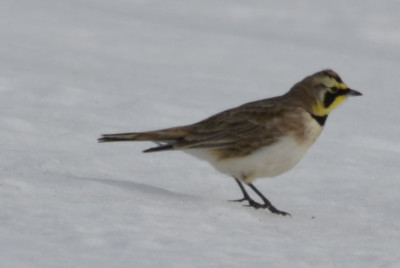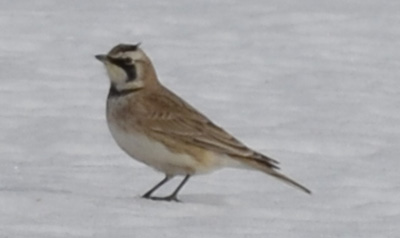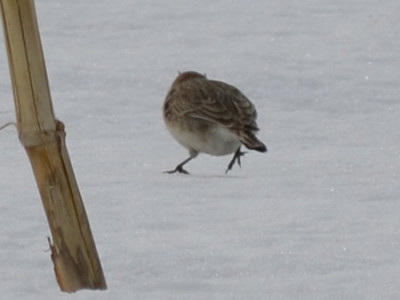I have seen Meadowlarks, though not for a few years, but I didn’t realize that another “lark” was lurking not far from my home. While reading Bird Alerts for my part of southern Ontario, I noticed mention of flocks of Horned Larks. Curious I looked them up and then I went looking for some. Along the way I discovered that not all small brownish birds feeding in flocks on the gravel edges of farm roads are sparrows: some are Horned Larks.
Horned Larks Really Are Larks
Meadowlarks and Horned Larks both have some splashes of bright yellow on their front and a black necklace. Their backs are a dull brownish colour. They both like farm country, too. That’s about where the similarities end though.
For one thing, Horned Larks truly are Larks. Meadowlarks are not. Meadowlarks are in the Blackbird family. I couldn’t find a clear answer on who named Meadowlarks but there are vague references to their songs reminding European and British settlers of Skylarks.
For another thing, these birds don’t like to eat the same things or find food the same way.
According to AllAboutBirds, Eastern Meadowlarks have long bills and they prefer to eat insects. They probe the ground looking for lunch. They will eat seeds in the winter when insects are hard to find. Oppositely, Horned Larks will catch insects in the summer but year-round they eat seeds. Their beaks are short and strong.
Local Horned Larks Rely on the Kindness of Strangers
Based on some eBird.org sightings from a few years ago, I went out one February afternoon in search of some Horned Larks.
I was very pleased to find them, in basically the same spot as two years previously. The reason was immediately obvious: some kind soul, probably one of the nearby farmers, was feeding them. A long stretch of the fine gravel shoulders of the road on both sides was generously coated with corn kernels.
Horned Larks Seem to Have Learned to Beware of Vehicles
Somewhat to my surprise, despite being encouraged to feed just inches away from a fairly busy concession road, the Horned Larks were not suffering for it. Instead, they seemed to have learned to beware of vehicles.
Time after time, usually just after I had them in focus, they would swoosh up and back out over the fields just before a vehicle got within ten feet. They would fly, calling, then settle amongst the short shorn corn stalks for a few minutes.
Ever busy, they would run rapidly through the corn field, stopping to probe into crevices and nooks presumably for seeds. (There were no apparent insects on the icy fields although it is remotely possible a few were out there that I couldn’t see.)
Then, a few would wing up, quickly joined by others, and flit back to the road edge.
As this out of focus photo shows, even when the Larks were forced to abandon the riches at the roadside, they often took a snack with them.
But What KIND of Horned Larks Are These? Prairie or Northern?
I noticed when squinting at my blurry photos of the flock feeding that the plumages are not identical.
Looking up information about plumage differences led me to the unexpected discovery that there are two common types of Horned Larks in southern Ontario. The ones I was watching are called Prairie Horned Larks. Another kind, the Northern Horned Larks, weren’t in my flock.
Jean Iron has written up a detailed explanation of the colouring differences of these two sub-species. From her references, I was able to conclude that all of my Horned Larks were the Prairie kind as they all had a white superciliary stripe (eyebrow) not a yellow one. (Luckily Jean Iron mentioned that some Prairie’s have a bit of yellow very near the eye.) Apparently the stripe is bright yellow on Northern Horned Larks.
Jean Iron and others also say that the Northern Horned Larks are more common in this area on migration later in the spring, in March and April. So who knows, perhaps I’ll catch a glimpse of one of those later!
Do Prairie Horned Larks Nest in Southern Ontario?
Yes they do. In fact, they start to set up territories as early as March.
The Larks sing to defend their territories. While I did not get to hear that type of singing, I was impressed with what I did hear during my visit. Horned Larks have a very distinctive voice and they were calling frequently amongst themselves. Their vocalizations reminded me of pleasant sounding metallic pings, a bit like small bells. They sound quite unlike sparrows and other chipping or chattering birds.
Do Horned Larks Really Have Horns?
I don’t know: they didn’t play any while I was listening.
They do have black feathers which give them a cute look, even from the back view.
Keep Your Eyes On the Road/Side When Prowling Around the Farm Fields
So now I know to keep a sharper eye on any “sparrows” I see at the road sides. Even in summer they may be Horned Larks.
Related Reading
- What Sparrow Has Yellow Eyebrows in Southern Ontario?
- What Brown Sparrow Has a Yellow and Black Beak and is Wintering Here in Southern Ontario?
Join In
Have you seen any small birds larking around at the edge of the road? Are you already accustomed to their bell-like songs? Please share your experiences with a comment.

